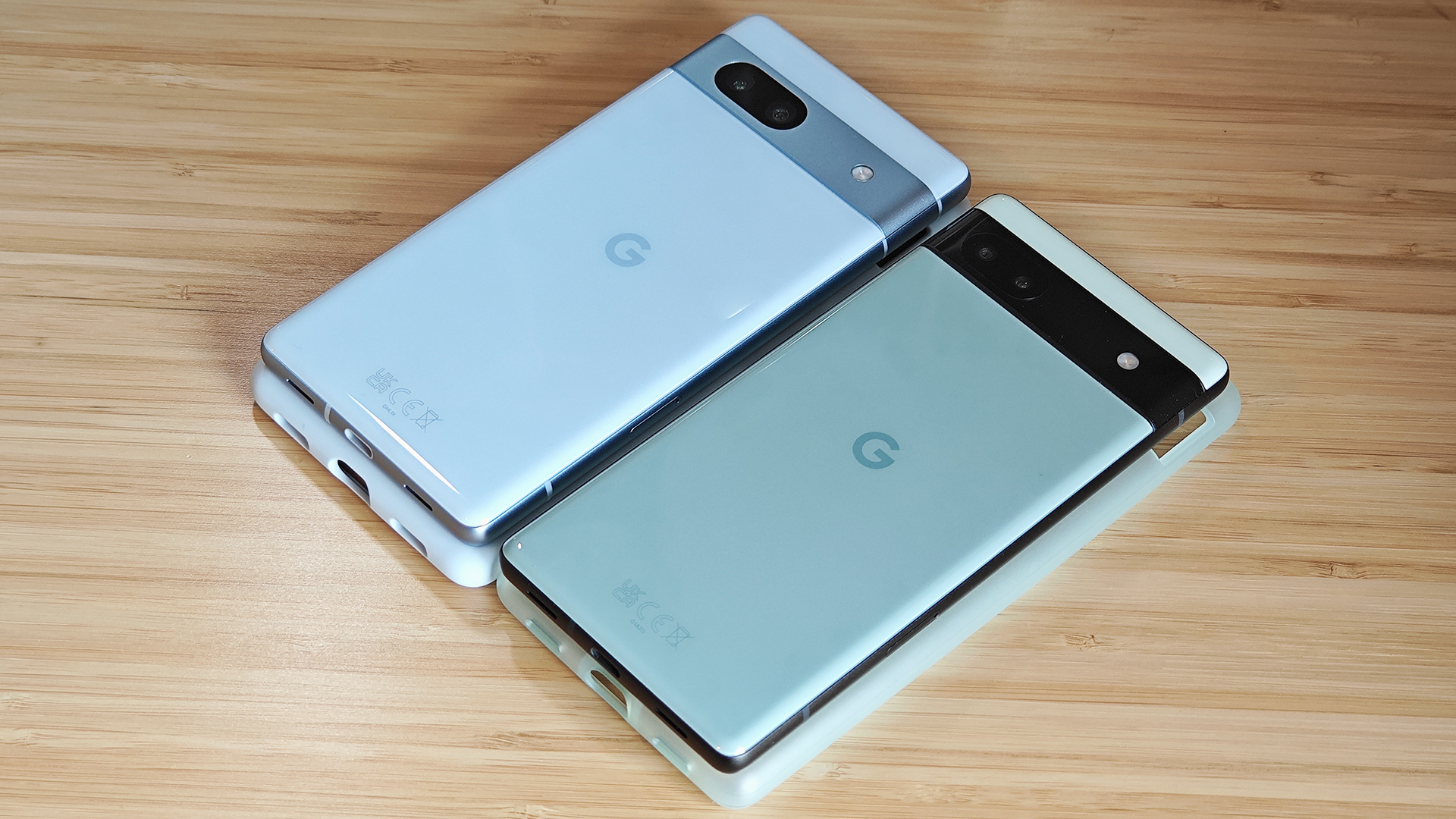Google Pixel 7a vs Pixel 6a: What's new in Google's affordable phone?
Google Pixel 7a and Pixel 6a: what's the difference between Google's entry-level Android phones?


The Google Pixel 7a has been announced with a £449/$499 asking price – which is £/$50 more than the Pixel 6a was when it launched in 2022. Thankfully, Google adds some fancy tricks to its latest 'lite' Pixel phone to justify the price bump – most notably, wireless charging.
Announced at Google I/O 2023, along with Google's priciest Pixel to date: the Pixel Fold. At the other end of the spectrum to the new folding phone, the Pixel 7a looks like an instant value champ on paper – and a keen contender for the best affordable phones.
In addition to wireless charging, the 7a also packs Google's latest chip, the Tensor G2, giving it Pixel 7 Pro-grade power. It also sports a massive camera sensor – the biggest we've seen at its price point – which suggests it will be even better at night photography. And with a smoother screen thanks to 90Hz refresh, it should also level up the viewing experience.
But are the upgrades actually worth it, or would you be better off saving your pennies and picking up a Pixel 6a with its slimmer, lighter design and more pared-back styling? Here's our Google Pixel 6a versus 7a comparison to help you decide...
Price
When it launched, the Pixel 6a cost £399/$449, which was very fair. Its main competition was the Nothing Phone (1) and the Samsung Galaxy A53, but for anyone after a true Android experience and loads of power without a premium, the Google was the best option around.
A year on from the 6a's launch and Google has upped the price for its successor, the Pixel 7a, by £50/$50 – a trend we've already seen in 2023 from Samsung with its Galaxy A53 and A54. It can be hard to justify a price hike without tangible features, so it's great to see that Google has upgraded the 7a in a few key areas. However, as you can see from the widget below, the 6a is now so much cheaper that it's hard to ignore...
Design
Looks-wise, while the Google Pixel 6a and Pixel 7a are clearly siblings, but they definitely aren't identical twins.
Get all the latest news, reviews, deals and buying guides on gorgeous tech, home and active products from the T3 experts
Firstly, the 6a's black metal frame has been swapped out for a colour-matched tint to mirror the phone's back panel. It's still blasted metal, so has a similar matte texture, but definitely looks less stark against the Pixel 7a's polished back, especially in its lighter colourways.
Speaking of colours, the 6a was available in Chalk, Charcoal and Sage, while the 7a is available in Charcoal, Sea, Snow, and if you pick it up from the Google Store, Coral is an exclusive option from there. You can see the Sea colour below (left), next to the older Sage (right) colour.

A photo of the Google Pixel 7a (left) alongside the Google Pixel 6a (right)
Side by side, it's clear that the Pixel 7a is also a chunkier phone, and its visor-like camera bump is more pronounced than that of the more slimline Pixel 6a. While on paper, there's only 0.1mm in it, with the 6a's profile clocking in at 8.9mm, and the 7a being 9mm, in the flesh, the 7a's heavier weight (193g versus the 178g 6a) makes it feels more substantial.
Both phones are IP67 rated, so dust- and water-resistant, they're both glass covered on the front, metal around the sides, and plastic around the back, and they both look unequivocally Pixel.
Display
When the Pixel 6a launched its display was a bit of a head-scratcher – as it only offered a 60Hz refresh rate. In other words, it missed out on the buttery smooth high-refresh-rate numbers of some much cheaper competition, like the 120Hz-toting Redmi Note 11 Pro.
With the Pixel 7a, however, Google has budged (but only a little) and upgraded the screen from 60Hz to 90Hz, making it almost as smooth as its top-end Pixel 7 Pro, and exactly matching the Pixel 7.
In the flesh, many can't tell the difference between 90Hz and 120Hz, but you can definitely tell the difference between 60Hz and 90Hz, so we're happy to see the latest a-series display levels-up as much as it needs to.
A 90Hz refresh rate is also better for battery-saving compared to a 120Hz spec, and given the size of the 7a's battery – more on that later – the slightly pared-back refresh rate compared to the Pixel 7 Pro and some competition might actually be a good thing.
While you'll notice the Pixel 7a's higher refresh rate over the 6a when swiping through feeds and the interface, if you mainly watch videos or play casual games, these are generally capped at 60Hz, so you'll be happy with either phone.
Both Pixel models have 6.1-inch OLED screens, they're both Wide Full HD resolution, and they both look seriously good, with excellent viewing angles and a punchy picture that's great for the asking price.
Hardware
What's fantastic about the Pixel 6a and 7a is they both get the same power as their pricier counterparts – despite costing a fair bit less money. That means the Pixel 6a has a Google Tensor G1 processor, while the 7a has the newer Tensor G2.
While the Tensor G2 isn't that much more powerful than the G1 was for things like gaming (only benchmarking around 10 per cent higher), it does pack a few less tangible benefits.
First, the G2 has more advanced machine learning than the G1. This should boost the speed of handy features like voice typing, dial out background noise when talking on calls, and even help the phone's battery last a little longer.
The Tensor G2 also has an upgraded Titan M2 security chip, so combines more secure face unlock with fingerprint unlocking (as seen on the 6a), and the 7a comes with five years of security updates, so it can be used for a year longer than the 6a's equivalent from purchase without security software lapsing.
The two phones ship with 128GB storage as standard, but neither has an expandable microSD card slot, so that's your lot, and while the Pixel 6a has 6GB RAM, the 7a ups this to 8GB, so it should be a bit more adept at heavy multi-tasking.
Perhaps the only area the Pixel 6a edges ahead of the 7a is in terms of its battery capacity, thanks to its slightly juicier 4410mAh cell, versus the 7a's 4385mAh. What the Pixel 7a does have that makes up for this, however, is wireless charging, which is a worthy trade-off for a few hundred milliampere hours if you ask us.
Cameras
The Pixel 7a is a complete camera overhaul when compared to the Pixel 6a. Specifically, the main camera sensor has been blown right up this year, from a tiny 1/2.55-inch sensor on the 6a, to a massive 1/1.37 sensor on the 7a. While that isn't quite Pixel 7 or 7 Pro size, for the price it's absolutely huge. For context, the identically priced iPhone SE's camera sensor is 1/3-inch in size, making the7a's sensor over double that size.
Why does sensor size matter? A bigger sensor has physically larger 'pixels', so can capture more light, meaning photos and videos taken at night and when the lights are low generally look better. Bigger sensors also create more depth when subjects are nearby, blurring out backgrounds without the need for any software-based portrait mode or computational smarts to emulate the effect.
| Google Pixel 6a | Google Pixel 7a | |
| Main camera | 12.2 MP, f/1.7 aperture, 1/2.55-inch sensor size, optical stabilisation (OIS) | 64MP, f/1.9 aperture, 1/1.37-inch sensor size, optical stabilisation (OIS) |
| Wide-angle camera | 114-degrees, 12MP, f/2.2 | 120-degrees, 13MP, f/2.2 |
| Front camera | 8MP f/2 | 13MP, f/2.2 |
While the Pixel 7a's 64-megapixel main camera is also much higher resolution than that of the 12MP Pixel 6a, it actually captures 16MP images, combining four pixels on the sensor and turning them into one in the final image.
With the 16MP images the Pixel 7a produces, plus its larger physical sensor size, it captures sharper shots that fare better when you crop into them than the 6a does. While the Pixel 6a has a larger aperture (f/1.7 versus f/1.9 on the Pixel 7a), the 7a's larger sensor still produces better shots.


While neither phone has optical zoom, in well-lit conditions the Pixel 7a has a much better zoom than the 6a, as you can see above. This is down to the 7a's bigger sensor, higher resolution, and newer hardware and software.
Google hasn't stopped at the main camera, switching out the 12MP ultra-wide camera of the 6a to a 13MP resolution camera on the 7a, and the selfie camera's seen a bump up too, from 8MP to 13MP.
Conclusion
There's no doubt about it: the Pixel 6a and 7a are great phones that cram a lot in for their asking price, despite being Google's most affordable models. But the Google Pixel 7a is the clear winner in virtually every respect, so long as you're happy to spend a little more.
Google has upgraded the Pixel 7a's design, which looks much more light-hearted and cohesive with its colour-matched metal frame, mirroring the colour of the phone's back panel. The phone's screen is smoother thanks to a 90Hz refresh rate, its camera is specced out with a bigger sensor and higher resolution, it packs in more power and superior future-proofing, and it's loaded with wireless charging too.
So while the Pixel 6a is still a mighty smartphone, especially at its now cut price, if given the choice between both phones then we'd pick the Pixel 7a in a heartbeat –and go so far as to say it's well worth an extra £50 over its predecessor.

Basil has been writing about tech for over 12 years, with bylines in TechRadar, Metro, Wired, and Digital Camera World – to name but a few titles. He expertly covers everything from mobile phones to smart devices, cameras, audio-visual hardware, and kitchen tech. In addition to his extensive journalism experience, Basil is also skilled in video production, content strategy, and vegan baking, and runs Tech[edit], a technology-focused YouTube channel.